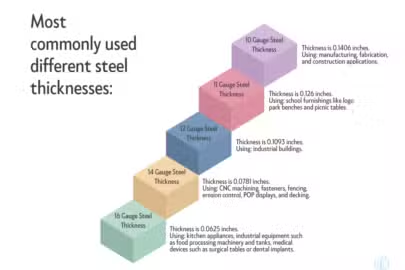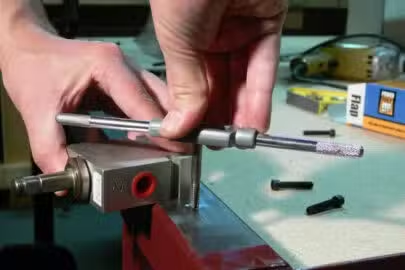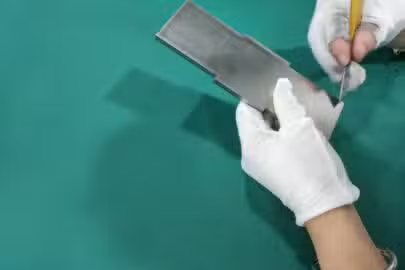Introduction
CNC machining is one of the most used manufacturing processes because it ensures the production of parts with high precision, regardless of design complexities. This manufacturing process is highly versatile and suitable for various materials, including steel.
Besides the high precision capabilities of CNC machining steel parts, its reliability and durability make these components one of the go-to parts for different industrial applications. Read ahead as we continue to explore the intricacies of CNC machining steel, including the properties of this alloy, its different grades, and other vital aspects.

What is CNC Machining Steel?
CNC machining steel is a computer-controlled process that uses a series of cutting tools to cut, shape, and form steel into various components. It’s a subtractive manufacturing process that uses what we refer to as Computer Numerical Control (CNC) technology, which ensures the high precision of the procedure.
Computer codes and programs control the operation of this manufacturing technique, including basic activities such as tool motion, cutting depth, and speed. Therefore, there’s little room for error, and the production of steel parts is fast and highly efficient.
Properties of Steel for Machining Purposes
Steel is one of the most used metal alloys for manufacturing because of its easy formability, usability, and durability. Without much ado, let’s examine some of the properties of steel that make it suitable for CNC machining operations.
Excellent Machinability
Besides aluminum, steel is arguably the most machinable metal, having an average machining greater than 100. The alloy allows easy, smooth, and efficient machining, ensuring fine steel surface finishing after cutting.
High Tensile Strength
Steel possesses considerable strength. Therefore, it gives a delicate balance of machinability, density, and toughness, making it a suitable metal for parts demanding mechanical loads and structural requirements. Typical steel alloys possess strength greater than 500MPa.
Wear and Tear-Resistant
Another beneficial property of steel for machining and manufacturing is its high resistance to wear and tear conditions. This property helps to ensure that CNC-machined steel parts will be durable and lasting for more extended periods. In fact, machinists further reinforce steel wear and tear resistance through heat treatment and surface hardening processes.
High Versatility
Steel is highly versatile, with varying grades for unique applications. Whether it is low-carbon steel, high-speed tool steel, or other distinct steel alloys, they find use in automotive, aerospace, electrical, or consumer and household goods manufacture.
Thermal Conductivity
Steel possesses effective thermal conductivity, which is beneficial for machining purposes. It allows optimum heat dissipation during machining, preventing heat build-up and eventual possible defects that may arise because of excess heat. Therefore, this property helps to ensure fewer machining defects.
Corrosion Resistance
Unlike typical iron metal, steel, an iron alloy has good corrosion resistance, a property the alloy develops because of chromium. This property allows steel for harsh applications, where the part may be exposed to moisture or corrosive chemicals.
Dimensional Stability
Compared to many metals, steel exhibits low thermal expansion. Therefore, even upon exposure to different temperature variations, such as during machining, it can maintain dimensional accuracy regardless of tight tolerance requirements.
This property, amongst others discussed above, makes steel a popular choice for CNC machining in different industries.

Grades of Steel for Machining
There are different grades of steel alloys suitable for machining purposes. This section will discuss some of the most common steel grades used for this manufacturing operation.
4130 Steel
This steel alloy is sometimes called chromoly or chromium-molybdenum steel because of the increased percentage of chromium and molybdenum. The increased content of these two elements increases the hardness and wear resistance of this alloy.
Therefore, it is preferred for fabrications and constructions that experience high-stress conditions. For example, manufacturers prefer this alloy for fabricating aircraft engine mountings. This application is also because it is more cost-effective.
Also, this alloy consists of other alloying elements, including carbon, phosphorus, sulfur, and silicon. Compared to standard steel, this alloy possesses improved machinability, toughness, and thermal compatibility. However, it does not possess good weldability.
4140 Steel
4140 steel is the low-alloy grade, consisting mainly of low levels of chromium, molybdenum, and manganese. However, it still possesses enhanced strength, ductility and toughness, high strength, and good overall mechanical properties. Also, the presence of chromium ensures that it has decent corrosion resistance.
Also, it possesses good machinability, making it a good candidate for CNC machining. Like 4130 steel, it responds well to hardening through heat treatments but maintains good weldability. This alloy is a popular choice for manufacturing different automotive parts, including gears and shafts, spindles, couplings, bolts, and nuts.
1018 Steel
1018 steel alloy is a low-carbon grade, though it possesses excellent machinability and weldability. The combo of this property makes this alloy the go-to option for carburized CNC steel parts. It is also a standard option for turning and milling operations.
It is not as tough as many steel alloys, making it a good option for fabrications where high strength is not critical but requires high precision machining and good steel surface finishing. This alloy is typical for manufacturing rods, bushings, couplings, shafts, spindles, and many other parts that require a material with high formability and weldability.
A significant shortcoming of the 1018 steel grade is its relatively high price and poor compatibility with standard surface finishing.
1045 Steel
The 1045 steel alloy is a medium carbon grade consisting of iron, silicon, sulfur or phosphorus, and manganese. It is a versatile steel grade for manufacturing because it showcases a delicate balance of machining and welding properties. Besides, it is strong and tough yet responds well to heat treatments like quenching and tempering to improve its hardness and strength.
Even with its considerable strength, there may be better choices for parts that prioritize high tensile strength. Instead, you should use stronger metals or other steel alloys. Typical applications of this steel grade include automotive parts like shafts, bolts, studs, gears, and hydraulic components.
1144 Steel
1144 steel is regarded as the stress-proof variant. It’s a modified steel alloy with excellent machinability, possessing high tensile strength with high impact and stress resistance. The combo of these properties makes it a good choice for CNC precision machining and for fabricating automotive parts like axles, studs, and bolts
1215 Steel
This steel alloy consists of a high percentage of sulfur, which helps to improve its machinability; consequently, it is called free-machining steel. Some machinists call it screw stock because of its prevalent use for automatic screw machine processes. It also contains decent amounts of manganese, phosphorus, and carbon.
1215 steel is suitable for automatic projects where heavy machining is crucial, including other applications such as hose fittings, couplings, studs, screws, and pins. However, it is less suitable for welding purposes, and since it has low carbon content, it is less strong than other alloys.
Benefits and Challenges CNC Machining Steel
Throughout this piece, we have explored some of the benefits and shortcomings of CNC machining steel. Indeed, steel is one of the most used metals in manufacturing, and because of its high tensile strength, it may prove challenging to work with. Hence, working with steel requires expertise on the part of the manufacturer.
Benefits
Most steel alloys and CNC steel parts possess good machinability and formability. Generally, these components have good mechanical properties, including hardness, strength, toughness, impact, abrasion and stress resistance, etc.
Therefore, steel parts are generally known to be durable, swallowing for long-term use. Moreover, they are often compatible with vast surface finishing to improve the general properties further. In addition, unlike metals, steel parts possess decent corrosion resistance, especially those manufactured from alloys with high chromium content.

Challenges
Even though steel is one of the most used metal alloys in industries, working with this alloy requires expertise, as not all grades are readily machinable. Therefore, when machinists fail to adhere to proper precautions, they may experience some difficulty with steel machining, especially for complex geometries. In addition, different steel grades have varying heat conductivity, so the temperature that hardens one may be intolerable for another.
CNC Machining Operations for Steel
Machining involves a series of cutting operations tailored to specific needs. Two standard CNC machining operations for steel include milling and turning. Without much ado, let’s examine either process.
CNC Milling Steel
CNC milling steel involves using rotary cutters to remove materials from a steel workpiece. The process is highly versatile, and yields machined steel parts with high precision and accuracy. It is the go-to CNC cooperation for creating complex structures and shapes with contours in steel components. Typical milling cutters for steel include high-speed steel, carbide, and cobalt high-speed end mills.
CNC Turning Steel
As mentioned earlier, CNC turning is another standard CNC operation for steel parts. The operation involves rotating the workpiece on a stationary lathe that gradually removes pieces of the material, resulting in a cylindrical CNC machined steel part.
Like all CNC operations, CN turning steel yields high efficiency, maintaining dimensional accuracy for parts with tight tolerance requirements. This process mainly benefits the manufacture of pins, shafts, and other rotatory components.
Criteria to Consider for Steel Machining
When CNC machining parts, it is vital that the engineer has the necessary technical know-how so that the fabrication adheres to all the required specifications. Below are other critical criteria to consider when machining steel.
Selecting the Right Steel Alloy
Selecting the proper steel alloy that best suits your fabrication needs is crucial to the CNC machining project. When determining the correct steel grade, consider the distinct properties, costs, and surface finishing compatibility.
For example, when fabricating parts that will require welding to fit them into larger structures, you shouldn’t use 4130 steel. Instead, steel alloys like the 1018, 1045, and 4140 will be a more suitable option for such fabrication.
Feed Rate of Cutting Tools
The feed rate of the cutting tool refers to the speed at which the cutters try to cut through the material. Machining at high-speed rates increases the chances of machining defects and deformation, as it may result in an excessive rise in temperature.
Therefore, optimizing the cutters’ feed rate may prove effective for ensuring efficient and precise CNC machining steel. You should also consider the hardness and toughness of the particular alloy. For example, softer steel alloys may require a higher feed rate, while the harder ones utilize a reduced feed rate to ensure optimum machining and prevent tool wear.
Design Constraints and Specifications
The design constraints and specifications are also critical criteria the machinist needs to consider when CNC machining steel components. This includes tolerance requirements, surface finishing, and shape or geometric complexities.
Selecting the Right Machining Tool
Besides all the criteria we have discussed, manufacturers must also select the right CNC machining tool for the fabrication. For example, when working with more challenging steel structures, carbide end mills are a better choice than high-speed mills because of their exceptional hardness and wear resistance.
Also, machinists should ensure that the geometry of the cutters matches the same and cutting edge angles, as this helps improve the machining results. Other criteria, such as the choice of coolant and lubricant during machinists, may also play a crucial role in averting machining defects.
Surface Finishing for CNC Machined Steel Parts
Different types of surface finishing operations suit CNC machining steel parts. Below is a brief overview of the more common ones.
Powder Coating
Like painting, powder coating involves spraying the surface of a metal, such as steel, with dry powder. The dry paint coat is usually about 0.15 to 0.3 mm thick, creating a decorative yet more durable steel surface finishing.
Other benefits of powder coating CNC machined steel parts include increasing corrosion resistance and improving color and appearance. Also, the paint is eco-friendly.
Nickel Plating
As the name suggests, it is a type of electroplating that involves depositing a nickel metal layer on the machined steel part. Nickel plating produces a thin layer of just about 0.1 mm. However, it enhances the steel’s chemical and mechanical resistance, improving its durability.
Carburizing
Carburizing is a typical heat treatment for steel machined parts. The process involves heating the steel metal with other carbon substances like charcoal and carbon monoxide. The resulting steel part possesses increased surface hardness, core toughness, tear, and wear resistance, all resulting in improved mechanical properties.
Brushing
Brushing, as a surface finish, involves rubbing the surface of a part with abrasive brushes or belts to create a distinct, attractive texture. Besides enhancing the aesthetics of CNC machined steel parts, it also reduces reflectivity, which benefits applications that require minimal glare. It also helps to mask machining defects and blemishes.
Bead Blasting
As the name suggests, bead blasting involves propelling or shooting small abrasive material (beads) against a manufactured part. Bead blasting a CNC machined steel component helps improve the aesthetics and surface properties of the material, as it results in creating a uniform and consistent texture around the steel part. It also helps to enhance the durability of the finished piece.
Applications of CNC Machined Steel
As reiterated throughout this article, CNC-machined steel components have applications across different industries. Below are typical industries that utilize CNC machining steel parts.

- Automotive: Engine components like shafts and connecting rods, including car chassis and suspension parts.
- Aerospace: Landing gear components like struts, axles, brackets
- Medical: Surgical equipment like forceps, scalpel handles, orthopedic implants
- Electronics: Connectors and housings
- Transportation: Components for rail systems, such as coupling systems and track switches.
- Energy and Power Generation: Steam turbine and power transmission components parts like gears, shafts, blades, and rotors
Zintilon: Your Expert Partner for Steel CNC Machining Services
Even with a detailed understanding of CNC machining steel, including its intricacies, acquiring these machines for your project can be a tad expensive, especially for a startup. Here is why you need to partner with a reputable service.
Zintillon is the partner you need to help you streamline your project. Whether small-scale or bulk-volume manufacturing, we offer expert services in CNC machining. Our facilities boast highly skilled and experienced machinists and engineers willing to help make your dream project a reality.
Besides machining, we also offer top-notch services in die casting, EDM (electrical discharge machining), sheet metal fabrications, custom parts fabrication, and other related technologies.
Conclusion
Steel is a highly versatile material with vast capabilities for various applications. It possesses many favorable characteristics that have made it one of the mainstay materials for multiple industrial applications. Even though it may sometimes prove challenging to machine, with the proper knowledge, machinists create high-quality CNC machined steel parts. Because of the unique qualities of this manufacturing process, it continues to open new capabilities on how to optimize steel used in the industry.




